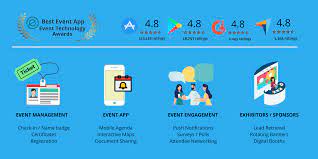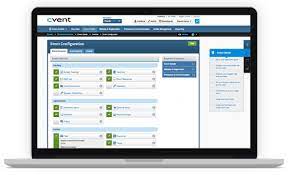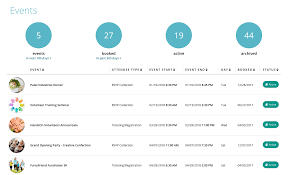Virtual Event Planning Software: Streamlining the Future of Events
In a rapidly evolving world, virtual events have become the new norm. With the rise of remote work and global connectivity, businesses and organizations are turning to virtual platforms to host conferences, trade shows, webinars, and more. As a result, the demand for efficient virtual event planning software has skyrocketed.
Virtual event planning software is designed to streamline the entire event management process, from initial setup to post-event analysis. It offers a wide range of features and tools that enable organizers to create engaging and interactive virtual experiences for attendees.
One of the key advantages of virtual event planning software is its ability to break down geographical barriers. Attendees can join from anywhere in the world, eliminating travel costs and logistical challenges associated with physical events. This opens up new opportunities for businesses to reach a larger audience and expand their global presence.
The software provides organizers with easy-to-use interfaces for building customizable event websites or landing pages. These platforms allow them to showcase event details, agendas, speaker profiles, and registration forms all in one place. Attendees can conveniently access this information and register with just a few clicks.
Engagement is crucial in any event, whether it’s physical or virtual. Virtual event planning software offers various engagement features such as live chat functionality, polling tools, Q&A sessions, gamification elements, networking opportunities, and even virtual exhibition halls. These interactive features keep attendees actively involved throughout the event and enhance their overall experience.
Furthermore, virtual event planning software provides robust analytics capabilities that allow organizers to measure success metrics accurately. They can track attendee engagement levels, session attendance rates, survey responses, lead generation data, and more. This valuable information helps organizers understand what worked well and what areas need improvement for future events.
Security is another critical aspect when hosting virtual events. Reliable software solutions offer advanced security measures such as encrypted data transmission and secure access controls. These features ensure that sensitive information remains protected, providing peace of mind to both organizers and attendees.
When selecting virtual event planning software, it’s essential to consider factors such as scalability, integration capabilities, and technical support. The software should be able to handle events of all sizes and seamlessly integrate with other platforms like CRM systems or marketing automation tools. Additionally, responsive customer support is crucial for troubleshooting issues that may arise during the event.
In conclusion, virtual event planning software has revolutionized the way we organize and experience events. It offers a wide range of features that simplify the entire event management process while providing a rich and engaging experience for attendees. As the world continues to embrace virtual events, investing in reliable virtual event planning software is an essential step towards hosting successful and impactful online gatherings.
Frequently Asked Questions: Virtual Event Planning Software
- What features should I look for in virtual event planning software?
- How much does virtual event planning software cost?
- What are the benefits of using virtual event planning software?
- How can I ensure my virtual events are successful?
- How easy is it to use virtual event planning software?
- Is there a way to test out different virtual event planning software before committing to one?
- Are there any free or open-source options for virtual event planning software?
- Are there any security considerations when using virtual event planning software?
- What support and training resources are available for users of virtual event planning software?
What features should I look for in virtual event planning software?
When searching for virtual event planning software, there are several key features you should consider to ensure a seamless and successful event. Here are some essential features to look for:
- Event Website Builder: Look for software that offers an intuitive and customizable event website builder. This feature allows you to create attractive event landing pages or websites where attendees can find all the necessary information, register, and access event resources.
- Registration Management: The software should provide robust registration management capabilities, allowing you to easily set up registration forms, collect attendee information, and track registrations in real-time. Look for features like ticketing options, discount codes, and the ability to customize registration fields.
- Live Streaming and On-Demand Content: Ensure that the software supports live streaming capabilities so you can broadcast sessions or presentations in real-time. Additionally, having the ability to offer on-demand content allows attendees to access recorded sessions or presentations after the event has ended.
- Interactive Features: Look for features that enhance attendee engagement such as live chat functionality, Q&A sessions, polling tools, virtual networking opportunities, and gamification elements. These interactive features keep attendees engaged throughout the event.
- Virtual Exhibition Hall: If your event includes exhibitors or sponsors, consider software that offers a virtual exhibition hall feature. This allows exhibitors to showcase their products or services through virtual booths and facilitates networking between attendees and exhibitors.
- Analytics and Reporting: The software should provide comprehensive analytics and reporting capabilities. This includes tracking attendee engagement levels, session attendance rates, survey responses, lead generation data, and other relevant metrics. These insights help you measure the success of your event and make data-driven decisions for future events.
- Integration Capabilities: Ensure that the software can integrate with other tools or platforms such as CRM systems or marketing automation tools. Integration enables seamless data transfer between systems and streamlines your overall event management process.
- Security Measures: Security is crucial when hosting virtual events. Look for software that offers advanced security features such as encrypted data transmission, secure access controls, and measures to prevent unauthorized access or data breaches.
- Technical Support: Consider the level of technical support provided by the software vendor. Responsive customer support is essential in case you encounter any issues or need assistance during your event.
By considering these features, you can choose virtual event planning software that aligns with your specific event requirements and ensures a smooth and engaging experience for both organizers and attendees.
How much does virtual event planning software cost?
The cost of virtual event planning software varies depending on several factors, including the features and functionality offered, the size and complexity of your event, and the duration of your subscription.
Some virtual event planning software providers offer pricing plans based on a tiered structure, where different levels of features are available at different price points. These plans typically range from basic packages with limited features to more comprehensive options that include advanced capabilities.
The pricing models can be based on a monthly or annual subscription fee. Monthly plans generally range from around $50 to $500 per month, depending on the provider and the level of features included. Annual plans often offer discounted rates compared to monthly subscriptions.
It’s important to note that some providers may charge additional fees for specific add-ons or premium features such as custom branding, dedicated customer support, or integration with other platforms.
Additionally, for larger-scale events or customized solutions, some virtual event planning software providers may offer enterprise-level pricing. These prices are usually negotiated directly with the provider based on your specific requirements.
To determine the exact cost for your needs, it’s recommended to research different virtual event planning software providers and request quotes or demos from them. This will allow you to compare prices and evaluate which option best fits your budget and requirements.
What are the benefits of using virtual event planning software?
Virtual event planning software offers numerous benefits that streamline the event management process and enhance the overall experience for both organizers and attendees. Here are some key advantages:
- Accessibility: Virtual events break down geographical barriers, allowing attendees to join from anywhere in the world. This expands the reach of events and increases attendance rates as participants can conveniently join without the need for travel or accommodation arrangements.
- Cost-Effectiveness: Hosting virtual events eliminates expenses associated with venue rentals, catering, travel, and accommodation. It significantly reduces overhead costs, making it a more budget-friendly option for organizers.
- Flexibility and Scalability: Virtual event planning software provides flexibility in terms of event size and format. Whether it’s a small webinar or a large-scale conference, the software can accommodate events of various scales. Organizers can easily scale up or down based on their needs.
- Customization: The software allows organizers to create personalized event experiences by customizing event websites, landing pages, registration forms, and branding elements. This enables them to maintain consistency with their organization’s identity and deliver a cohesive brand experience.
- Engagement Features: Virtual event planning software offers interactive features such as live chat functionality, Q&A sessions, polling tools, virtual networking opportunities, gamification elements, and virtual exhibition halls. These features keep attendees engaged throughout the event and foster meaningful interactions.
- Data Analytics: Comprehensive analytics capabilities provide organizers with valuable insights into attendee behavior and engagement levels during virtual events. They can track attendance rates, session popularity, survey responses, lead generation data, and more. This data helps organizers measure success metrics accurately and make informed decisions for future events.
- Time-Saving: Automated processes within the software save time for organizers by streamlining tasks like registration management, email communication, session scheduling, reminders, and post-event surveys.
- Enhanced Security: Reliable virtual event planning software ensures data security through encrypted transmission channels and secure access controls. This protects sensitive information and ensures a safe environment for attendees.
- Environmental Sustainability: By eliminating the need for physical travel and reducing carbon emissions associated with traditional events, virtual events contribute to a more sustainable approach to event planning.
- Global Reach and Networking Opportunities: Virtual events enable attendees to connect with professionals, industry experts, and peers from around the world. This opens up new networking opportunities, fostering collaboration and knowledge sharing on a global scale.
In summary, virtual event planning software offers a wide range of benefits that optimize event management processes, increase accessibility, enhance attendee engagement, provide valuable data insights, and contribute to cost savings. It is an invaluable tool for organizing successful virtual events in today’s digital landscape.
How can I ensure my virtual events are successful?
Ensuring the success of virtual events requires careful planning and execution. Here are some key tips to help you make your virtual events a resounding success:
- Define clear objectives: Start by clearly defining your event’s goals and objectives. What do you want to achieve? Whether it’s generating leads, educating attendees, or fostering networking opportunities, having a clear focus will guide your planning process.
- Choose the right virtual event platform: Selecting the right virtual event platform is crucial. Look for a platform that offers the features and functionalities you need, such as live streaming capabilities, interactive tools, networking options, and analytics. Test the platform beforehand to ensure it meets your requirements.
- Engage your audience: Engagement is key in virtual events. Incorporate interactive elements like live polls, Q&A sessions, chat features, and gamification to keep attendees engaged throughout the event. Encourage participation and create opportunities for networking and discussion.
- Plan engaging content: Develop compelling content that aligns with your event’s objectives. Consider a mix of pre-recorded presentations, live sessions with industry experts, panel discussions, and interactive workshops to keep attendees interested. Ensure your content is informative, relevant, and tailored to your target audience.
- Provide technical support: Technical issues can arise during virtual events. Ensure you have dedicated technical support available throughout the event to troubleshoot any problems that attendees may encounter with audio/video connections or accessing content.
- Promote your event effectively: Implement a comprehensive marketing strategy to drive attendance for your virtual event. Utilize email marketing campaigns, social media promotion, targeted advertising, and partnerships with influencers or industry associations to reach your target audience effectively.
- Test and rehearse: Conduct thorough testing of all technical aspects before the event goes live. Test audio/video quality, connectivity issues, and ensure all presenters are comfortable with the platform’s features through rehearsals or run-throughs.
- Provide post-event resources: After the event, provide attendees with access to recorded sessions, presentation materials, and additional resources. This allows attendees to revisit content and provides value beyond the live event.
- Gather feedback and analyze data: Send out post-event surveys to collect feedback from attendees. Analyze data such as attendance rates, engagement metrics, and survey responses to evaluate the success of your event and identify areas for improvement.
- Continuously improve: Learn from each virtual event you host and incorporate feedback into future events. Stay updated on emerging trends in virtual events and technology to ensure you are delivering the best possible experience for your audience.
By following these tips and continuously refining your virtual event strategy, you can create engaging, informative, and successful virtual events that leave a lasting impact on your attendees.
How easy is it to use virtual event planning software?
Virtual event planning software is designed to be user-friendly and intuitive, making it accessible to both experienced event organizers and those new to virtual events. The ease of use can vary depending on the specific software platform, but most providers strive to create interfaces that are simple and straightforward.
Many virtual event planning software solutions offer drag-and-drop functionality, allowing organizers to easily customize event websites or landing pages without the need for coding knowledge. This makes it easy to add content, update information, and make changes on-the-fly.
Setting up registration forms and ticketing options is typically a seamless process with pre-built templates or customizable fields. Organizers can easily collect attendee information, set pricing tiers, and manage ticket sales within the software platform.
Managing sessions, agendas, and speaker profiles is also made simple with intuitive interfaces. Organizers can create schedules, assign speakers or panelists, and make updates as needed. Some software even offers features like automated session reminders or notifications to keep attendees informed.
Engagement tools such as live chat functionality, polling features, or networking opportunities are often designed to be user-friendly for both organizers and attendees. These tools can be easily integrated into the virtual event platform, allowing for smooth interaction between participants.
While virtual event planning software aims to provide a streamlined experience, there may still be a learning curve associated with more advanced features or customization options. However, most providers offer comprehensive support resources such as tutorials, documentation, or customer support channels to assist users in navigating the software effectively.
Ultimately, the ease of use will depend on factors such as individual familiarity with technology and specific software preferences. It’s recommended to explore different virtual event planning software options and take advantage of free trials or demos to determine which platform aligns best with your needs and comfort level.
Is there a way to test out different virtual event planning software before committing to one?
Yes, many virtual event planning software providers offer trial periods or demo versions of their platforms. This allows you to test out the software and explore its features before making a commitment. During the trial period, you can get a hands-on experience with the platform, create sample events, interact with the various tools, and evaluate its suitability for your specific needs.
To find virtual event planning software with trial options, you can visit the websites of different providers and look for information on free trials or demos. Some providers may require you to sign up or provide basic contact information to access the trial version. Take advantage of these opportunities to thoroughly assess the software’s capabilities and determine if it meets your requirements.
Additionally, it can be helpful to read reviews or seek recommendations from others who have used virtual event planning software. This can provide insights into user experiences and help you make an informed decision when selecting a platform to try.
Remember that testing out different software options before committing allows you to compare features, user interfaces, ease of use, customer support, and pricing structures. By doing so, you can ensure that the virtual event planning software you choose aligns with your goals and helps deliver a successful event experience for both organizers and attendees.
Are there any free or open-source options for virtual event planning software?
Yes, there are several free and open-source options available for virtual event planning software. Here are a few popular ones:
- Jitsi: Jitsi is an open-source video conferencing platform that allows users to host virtual events, webinars, and meetings. It supports features like screen sharing, chat functionality, and recording capabilities.
- Open Conference Systems (OCS): OCS is an open-source software designed specifically for academic conferences. It offers features for abstract submission, scheduling, registration management, and publishing conference proceedings.
- BigBlueButton: BigBlueButton is an open-source web conferencing system that focuses on online learning and virtual classrooms. It provides features like real-time collaboration tools, breakout rooms, polling, and whiteboarding.
- Pretix: Pretix is an open-source ticketing software that can be used for organizing virtual events as well. It offers features such as ticket sales, attendee registration, payment processing integration, and customizable event pages.
- Open edX: Open edX is an open-source platform primarily used for hosting online courses and educational content. However, it can also be utilized to organize virtual conferences or events with its built-in discussion forums, live streaming capabilities, and interactive courseware.
These options provide a starting point for those looking for free or open-source solutions to manage their virtual events effectively. However, it’s important to note that while these platforms offer basic functionalities, they may not have the same level of customization or advanced features compared to paid event planning software solutions.
Are there any security considerations when using virtual event planning software?
Absolutely, security considerations are crucial when using virtual event planning software. Here are some key aspects to keep in mind:
- Data Protection: Ensure that the software provider offers robust data protection measures. Look for features like encrypted data transmission, secure storage, and adherence to industry-standard security protocols.
- Access Controls: Implement strong access controls to prevent unauthorized access to sensitive event information. Utilize features like password protection, multi-factor authentication, and role-based permissions to ensure that only authorized individuals can access and modify event data.
- Privacy Policies: Review the software provider’s privacy policies and terms of service to understand how they handle and protect your data. Ensure that they comply with relevant privacy regulations, such as the General Data Protection Regulation (GDPR) if applicable.
- Secure Payment Processing: If your event involves ticket sales or transactions, make sure that the software integrates with secure payment gateways to protect financial information. Look for compliance with Payment Card Industry Data Security Standard (PCI DSS) requirements.
- Participant Verification: To prevent unauthorized attendees from joining your virtual event, consider implementing participant verification mechanisms such as unique access codes or registration confirmation emails.
- Regular Updates and Maintenance: Choose a software provider that regularly updates their platform with security patches and bug fixes. Promptly applying these updates helps protect against potential vulnerabilities.
- Staff Training: Educate your event planning team on best practices for maintaining security during the planning and execution of virtual events. This includes awareness of phishing attempts, secure password management, and proper handling of sensitive information.
- Backup and Recovery: Ensure that the software offers regular backups of event data in case of any unforeseen incidents or technical failures. Having a reliable backup system helps minimize data loss and ensures business continuity.
Remember, it’s essential to thoroughly research and assess the security features provided by different virtual event planning software providers before making a decision. Prioritizing security will help safeguard your event data and protect the privacy of both organizers and attendees.
What support and training resources are available for users of virtual event planning software?
Virtual event planning software providers understand the importance of providing comprehensive support and training resources to ensure users can make the most out of their platforms. Here are some common support and training resources that are often available:
- Documentation and Knowledge Base: Most software providers offer extensive documentation, user guides, and FAQs to help users navigate through the platform’s features and functionalities. These resources provide step-by-step instructions, best practices, and troubleshooting tips.
- Video Tutorials: Many virtual event planning software providers create video tutorials that visually guide users on how to use different features within the platform. These tutorials are often accessible on the provider’s website or YouTube channel.
- Webinars and Online Training Sessions: Providers may offer live webinars or online training sessions where users can join interactive sessions led by experts. These sessions cover various topics, including platform walkthroughs, advanced features, and tips for maximizing engagement.
- Dedicated Support Channels: Software providers typically offer dedicated support channels such as email, live chat, or phone support for users to reach out with their queries or technical issues. Users can directly contact the support team for prompt assistance.
- Community Forums and User Groups: Some virtual event planning software providers have community forums or user groups where users can interact with one another, share experiences, ask questions, and learn from each other’s insights.
- Onboarding Assistance: For new users or organizations transitioning to virtual events for the first time, some software providers offer onboarding assistance in the form of personalized training sessions or consultations to ensure a smooth transition onto their platform.
- Account Managers: In certain cases, larger organizations or clients may be assigned dedicated account managers who act as a point of contact for ongoing support and guidance throughout their usage of the virtual event planning software.
It’s important to note that the availability of these resources may vary among different software providers. It is advisable to explore the specific offerings of each provider to determine which resources best align with your needs and preferences.




